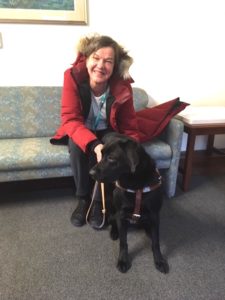DeafBlind Community Speaks Out About COVID-19 Fears
by Beth

That’s me in my big red coat along with my Seeing Eye dog Luna in January, before we started sheltering in place.
I live on the seventh floor of a high rise in Chicago. These days I don a mask and disposable gloves any time I have to leave the apartment. When it’s time for me to take my Seeing Eye dog outside to “empty,” she knows to guide me through a long hallway right to the buttons. “Luna, sit!” I say, and she stays still as I put on my disposable plastic gloves and feel for the one that says “down.” When an elevator dings twice, I know it’s arrived and will be going down (one ding means up, two dings mean down). I point that way, command “forward!” and Luna leads me to the opening. “Anybody in here?” I ask. I’m not so sure our elevators here are even six feet wide, so if someone answers, I urge them to go ahead without us: I’m not pressed for time.
I’ve made a great discovery in the past four weeks: when wearing plastic disposable gloves, you can still feel the Braille dots in the elevator! Assuming bad guys are staying home during the pandemic, I am fearless when out with Luna after dark for her final “empty” of the day. Once outside, without being able to see, unless people talk — or walk — loudly, it can be difficult to judge what six feet is, but Luna and I do our best.
Read those last couple of paragraphs again and you’ll notice how heavily I rely on my sense of sound to navigate the world and keep myself –and others –safe: one ding from the elevator tells me it’s about to head up, two dings means it’s going down; if no one responds to my question at the elevator doors, I know it’s okay to enter; using footsteps, along with a little eavesdropping, to alert me where others are and allow me to do my best to keep a required six feet between us.
How would I accomplish all this if, in addition to being blind, I couldn’t hear? A Washington Post article called They are deaf and blind, and social distancing has now taken their ability to touch answers that question. The article addresses how important the sense of touch is to those of us who can’t see, and, especially, to those who are both deaf and blind. “The DeafBlind community includes people who have zero ability to see and hear, and those who have so little that they have been medically deemed deaf and blind,” the article explains. From there the reporter interviews individuals from all over the country who are DeafBlind to ask how they are faring during the unthinkable times we are living in now.
While I couldn’t relate to all of the experiences , some of the things people who are DeafBlind are going through do, dare I say, ring a bell:
- Social distancing creating unique worries and exceptional challenges
- Isolation forcing us to grow increasingly disconnected when, more than ever, we need to be aware of what’s happening around us
- It being uncomfortable to rely on your sense of touch at a time when grabbing a doorknob or standing closer than six feet from a stranger carries risks.
- The story pointed out a feeling many of us with disabilities have right now: the worry that hospitals facing scarce resources will decide not to save the lives of those of us with disabilities. Haben Girma, the author of a memoir titled Haben: The DeafBlind Woman Who Conquered Harvard Law, was interviewed for the article and told the reporter that ”there is an ableist assumption that causes some people to think it’s better to be dead than disabled” and that, plus the worry that she might not be able to communicate with medical staff if she does end up hospitalized, is what keeps her up at night now.The story ends with a quote from an email message sent by Ali Goldberg, a DeafBlind student at Gallaudet University majoring in education who uses tactile sign language to communicate:
In that email, he described feeling “afraid for the future.”
He also expressed an appreciation for being able to talk about how social distancing is affecting him and a hope that it would help more people understand what the DeafBlind community is going through right now.
The experiences of the DeafBlind community may be unique, but their concerns shouldn’t be theirs alone.
“As a Deaf-Blind individual like myself, we are left out of everything going on around us,” he wrote. “Let’s get through this together.”







April 29th, 2020 at 6:17 pm
Znakomstva na vecher http://www.tinyurl.com/ya2govax